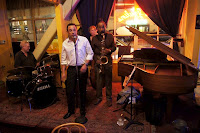 I have a history of missing bassist Tamara Murphy so I’m relieved to have finally caught her but it was a close thing. Tamara was here again with the Fran Swinn Trio at Hippo on a tour to launch their new CD. Even this time I only managed to get there for their final set after another engagement. I’d missed this trio with a circus act a few months before and Tamara a string of times in the past. Then when I was recently at the David Gage bass shop in NYC, I mentioned Australia and they volunteered Tamara Murphy, which impressed me. So finally I catch up.
I have a history of missing bassist Tamara Murphy so I’m relieved to have finally caught her but it was a close thing. Tamara was here again with the Fran Swinn Trio at Hippo on a tour to launch their new CD. Even this time I only managed to get there for their final set after another engagement. I’d missed this trio with a circus act a few months before and Tamara a string of times in the past. Then when I was recently at the David Gage bass shop in NYC, I mentioned Australia and they volunteered Tamara Murphy, which impressed me. So finally I catch up.This trio plays an impressionistic music of varied times and angular melodies and with that indefinite pitch that I hear in some modern jazz guitar. The underlying harmonies often sound of limited chords and the bass is more riffish than chordal. Fran’s guitar solos break from this with modern substitutions, a general freedom of harmony and sequences that move over symmetrical changes and into and out of dissonance using a sharp, trebly tone with echo effects and finger picking along with plectrum. I thought of Scofield and Fran mentioned Metheny and Frisell. Tamara took frequent solos which were more consonant and with a lovely sense of intervallic melody, although I did wonder at the exotic scales she was playing (this was not obvious major tonality). These were clearly double-bass solos of intellect and movement and with a fair touch of speed and with a unusual double-speed note pairs out of little two-finger fills. Tamara was playing on a borrowed gut-strung bass. I‘m not sure of her normal instrument and its stringing, but it would be interesting to see what changes this different bass has wrought in her playing. Ben’s drumming initially seemed sparse and truncated and soft (question my feminist credentials, but for the first solo I thought of a local lack of testosterone) but that was just the first solo I heard. Later, there were solos of volume and rolls and busy-ness, and these solos were frequent and surprisingly short (which I felt that suited the band) and of a modern approach that felt to me like storytelling.
The tunes were presumably originals, although I thought Fran said we’d recognise the last tune of the night (I didn’t). I counted 7s and a 5/4 ballad and had difficulty counting some others so I guessed odd counts like 13s or 15s. The melodies were jagged and unexpected to my ear, but attractive too. The form was mostly standard head-solos-head, but there was variation, and the solos were not particularly different from the head in structure or conception, so there was a consistency within and between tunes which seems to me a mark of impressionism. It all makes for an interesting palette and a desire on my part to revisit people like Metheny and Meldau and their impressionistic ilk.
Fran Swinn (guitar) led a trio with Tamara Murphy (bass) and Ben Hendry (drums).

















































